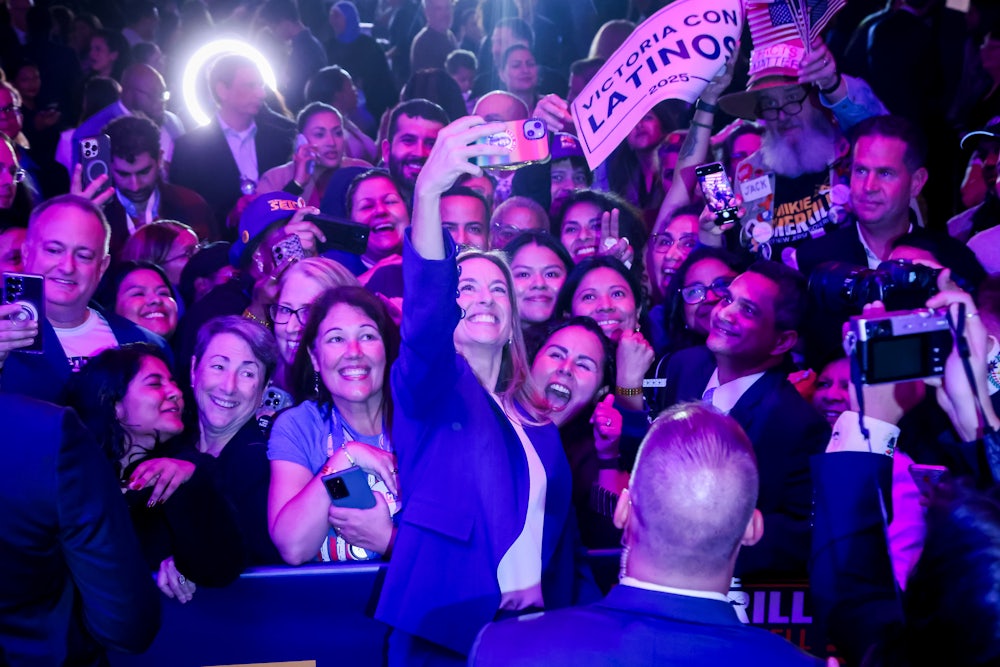When Mikie Sherrill was elected to be the next governor of New Jersey earlier this month, her success was due in no small part to support from the Garden State’s Latino voters. Although Latinos in New Jersey swung to the right in 2024, a trend that mirrored the drift away from Democrats nationally, Sherrill’s ability to recapture Latino support has Democrats hopeful that President Donald Trump’s appeal is fading for these voters.
It was one of election night’s most eye-popping results. Sherrill won by a wide margin, defying preelection stories about lagging enthusiasm for her campaign. That she improved significantly upon Vice President Kamala Harris’s performance in New Jersey among Latino voters was a big reason why. Union City and Perth Amboy, the two cities with the greatest percentage of Hispanic voters in the state, swung dramatically back to the left after shifting toward Republicans in 2024. In Passaic County, which has a population that is 43 percent Hispanic, Sherrill beat Republican Jack Ciattarelli by roughly 15 points; in 2024, Trump had won the county by three percentage points.
Although turnout in Passaic County, which includes Passaic and Paterson, was relatively low compared to other counties—and significantly lower than in the 2024 elections—the share of voters casting ballots increased significantly from the last gubernatorial election in 2021. After Democratic support in Passaic declined sharply between the 2017 and 2021 elections, it jumped significantly in 2025—the single greatest improvement in Democratic margin of any county, according to analysis by Solidarity Strategies, a Democratic consulting group that worked with the Sherrill campaign and state party ahead of the election.
Patricia Campos-Medina, a progressive Latina organizer who advised Sherrill’s campaign, credited Sherrill’s success in large part to the candidate’s emphasis on building infrastructure in heavily Hispanic communities.
“There wasn’t enough of a field operation targeting voters, talking to voters early, knocking on doors, and we set out to build a volunteer canvassing operation and a paid canvassing operation,” she said.
Campos-Medina continued that Sherrill’s campaign ticked several boxes in ensuring success with Latino communities: an effective message, a candidate that is “out there making local alliances,” and a field operation that is bolstered by outside support. The campaign was supported by the state party and the Democratic National Committee, which had conducted polling that helped identify top issues for Latino voters in the state. She also noted that outside groups such as Unidos US Action PAC and Latino Victory invested in the race, and praised Sherrill’s work with a “new set of field consultants that were focused on Latino get out the vote operations.”
“We didn’t rely on one field consultant to do a general operation. We actually broke it down into different expertise, and were able to get rooted in the community,” she said.
The Sherrill campaign launched a bilingual paid media campaign between Labor Day and Election Day, which specifically targeted Latino voters with advertising on broadcast, cable, radio, and digital platforms. Chuck Rocha, the founder of Solidarity Strategies, also noted that there was an “intentional investment” not only from the Sherrill campaign but from the state party and the Democratic National Committee, as well.
Sherrill’s campaign was not the only organization engaging with Latino voters. Make the Road Action New Jersey, an advocacy group that encourages Latino civic participation, engaged with voters in Elizabeth, Perth Amboy, and the city of Passaic to ensure that they were aware of the stakes of the election. The political arm of Make the Road Action NJ joined other progressive organizations in endorsing Newark Mayor Ras Baraka in the primary, but continued its outreach efforts in the lead-up to the general election. This was accomplished through a “layered program,” said Nedia Morsy, the organization’s director, reaching voters through seven million digital ad impressions, 260,000 calls, 130,000 text messages, and knocking on 60,000 doors.
This electoral effort bloomed from deep roots. Well before becoming involved in election activities, the nonprofit arm of Make the Road participated in a nonpartisan campaign to engage with voters year-round and encourage civic participation. Morsy said that the canvassing effort reached Latino voters who admitted to voting for Trump but felt betrayed by his administration’s actions on immigration.
“It was such an important year to launch a year-round canvassing program because of how quickly the administration operated,” said Morsy. “You wanted to be there with people to help make meaning, and also to connect the dots that what is happening out there is actually connected to a gubernatorial race.”
She added that even though Latino voters swung to the right in 2024, their priorities have not changed—it is a matter of who they believe has their best interests at heart, rather than a shifting in their actual positions. She noted that although Passaic County supported Trump in 2024, it voted for Baraka in the gubernatorial primary.
“The idea is that Latinos have left the party, but the actual, truer story is that Latinos have actually been the most consistent. They’ve said that they are concerned about keeping their family safe [and] being able to provide a roof over their head,” Morsy said. “It’s not that Black and brown voters are going through an identity crisis. It really is that we know we have parties and candidates who unfortunately have not been able to deliver on their promises.”
The results in New Jersey were, in part, a rejection of Trump’s seeming lack of action on the economy. Recent polling of Latino voters nationwide has shown widespread disapproval of his approach to the economy, as well as opposition to his immigration policies; an October poll by Equis found that 68 percent of Latino voters disapprove of how Trump is handling the cost of living. Another survey by Somos Votantes and Somos PAC released this week found that 36 percent of Latino voters who supported Trump in 2024 now say that they are disappointed or regret their decision.
Indeed, Sherrill’s campaign has credited much of her success to her messaging focus on “affordability.” Rocha said that Democrats as a whole have often erred in a lack of specificity, saying that they want to keep costs down without providing concrete examples of what that means. By focusing specifically on high utility costs, and promising to freeze energy rates for a year—a proposal that may be easier said than done—Sherrill offered a tangible example of her goals as governor.
“If you think about the last few elections, you haven’t heard anybody talk about utility costs. You hear about, oh, inflation or jobs or the economy—these words that aren’t really hyper-focused on what your problem is,” said Rocha.
While a secondary priority, immigration was also top of mind for Latino voters in New Jersey. Campos-Medina said that Latino immigrants who have become citizens and are able to vote are often “separated from the real crisis of immigration enforcement for about 10 to 15 years.” These voters may have been swayed to support Trump because of his promises to deport undocumented immigrants convicted of crimes. But Trump’s immigration policies have resulted in the detention of citizens and the deportation of undocumented immigrants who are not criminal offenders.
“The underlying theme everywhere was this anxiety in the community of the overreach of this administration. People don’t like seeing masked agents in their neighborhoods. They don’t like seeing law-abiding grandmothers and grandfathers getting picked up,” Rocha said.
Exit polling from the New Jersey gubernatorial race found that a majority of Latino voters believe the Trump administration’s immigration policies have “gone too far,” and that the next governor should not cooperate with the president on immigration enforcement.
“It’s clear that Latino voters are rejecting what Trump is selling,” said Vanessa Cardenas, executive director of immigration rights organization America’s Voice.
But Cardenas also said that Democrats needed to come up with an “affirmative agenda” if they wanted to appeal to Latino voters across the country going forward, rather than simply relying on opposition to Trump. If Democrats want to build on their gains among Latino voters in the midterm election, both in New Jersey and across the country, they will need to give them something to vote for—and keep up the mobilization efforts that contributed to a decisive win in New Jersey.
“This kind of rejection for Trump doesn’t necessarily translate to the level of support that Democrats are going to need,” said Cardenas. “As we look to the midterms, Democrats really investing and engaging in having a policy platform that speaks to the concerns of Latinos, both on the economy but also on immigration, is going to be key.”
* This article originally misidentified Perth Amboy in Passaic County. The article has also been updated to reflect the correct name of Make the Road Action New Jersey and Nedia Morsy’s title.










